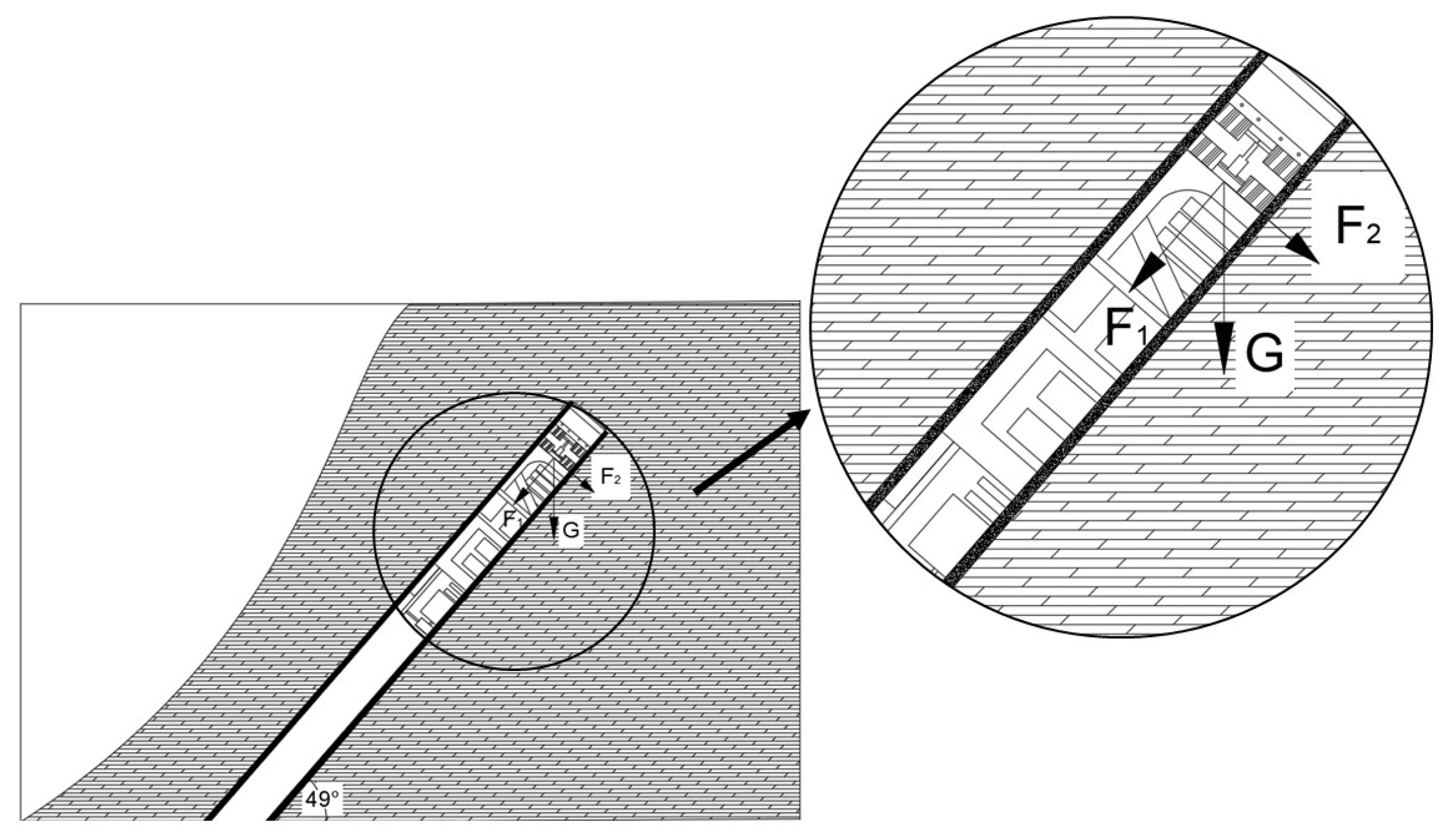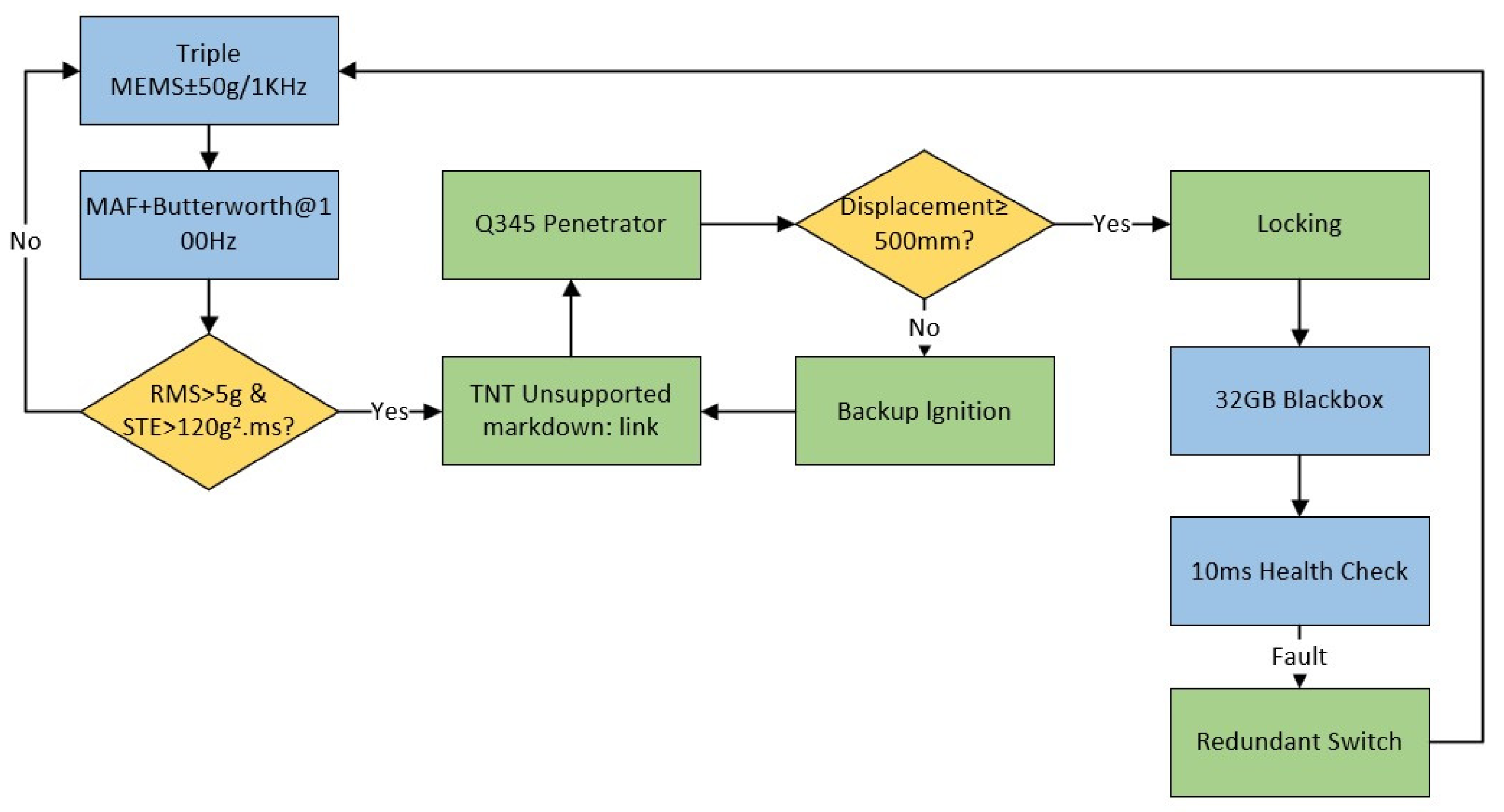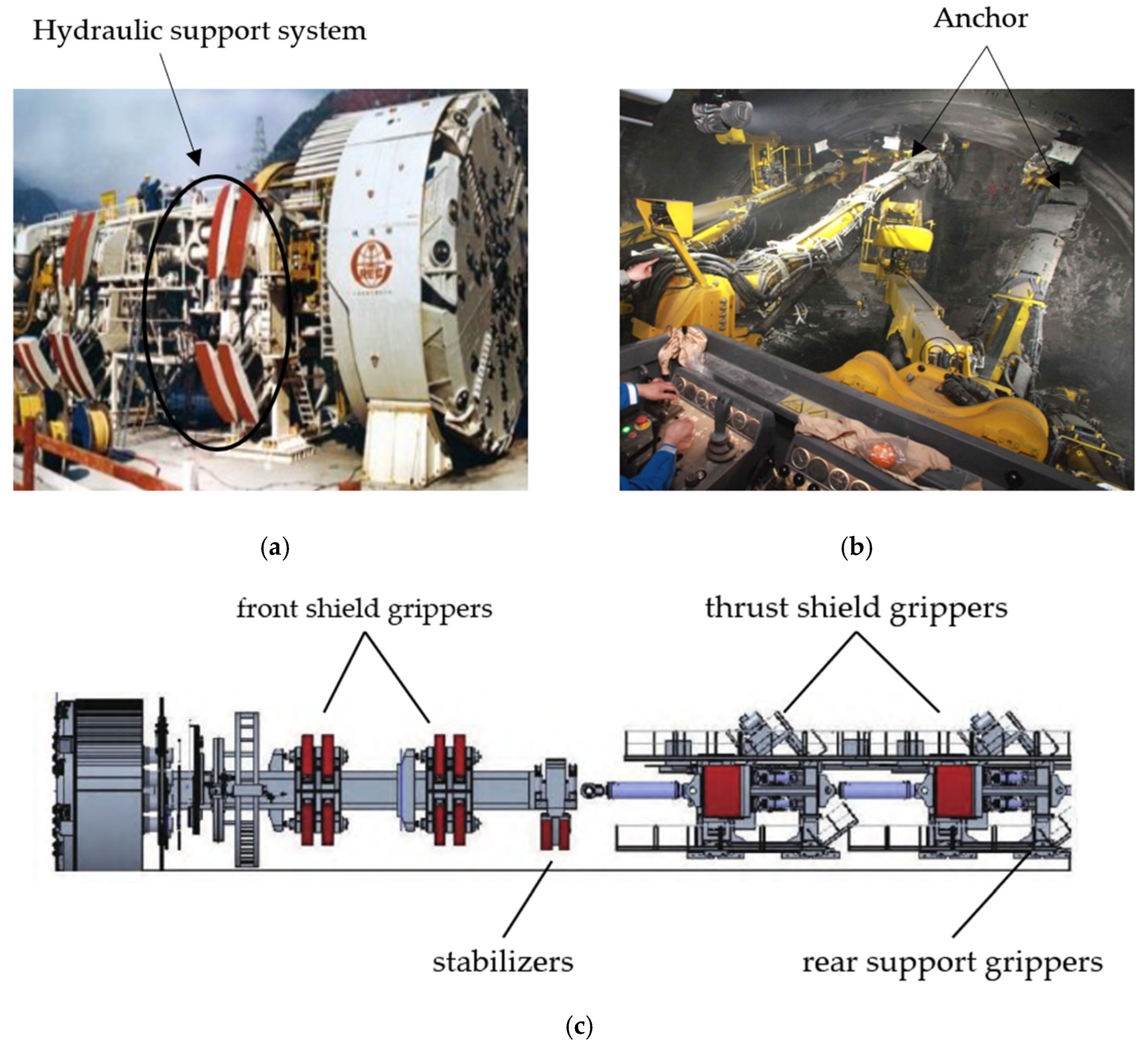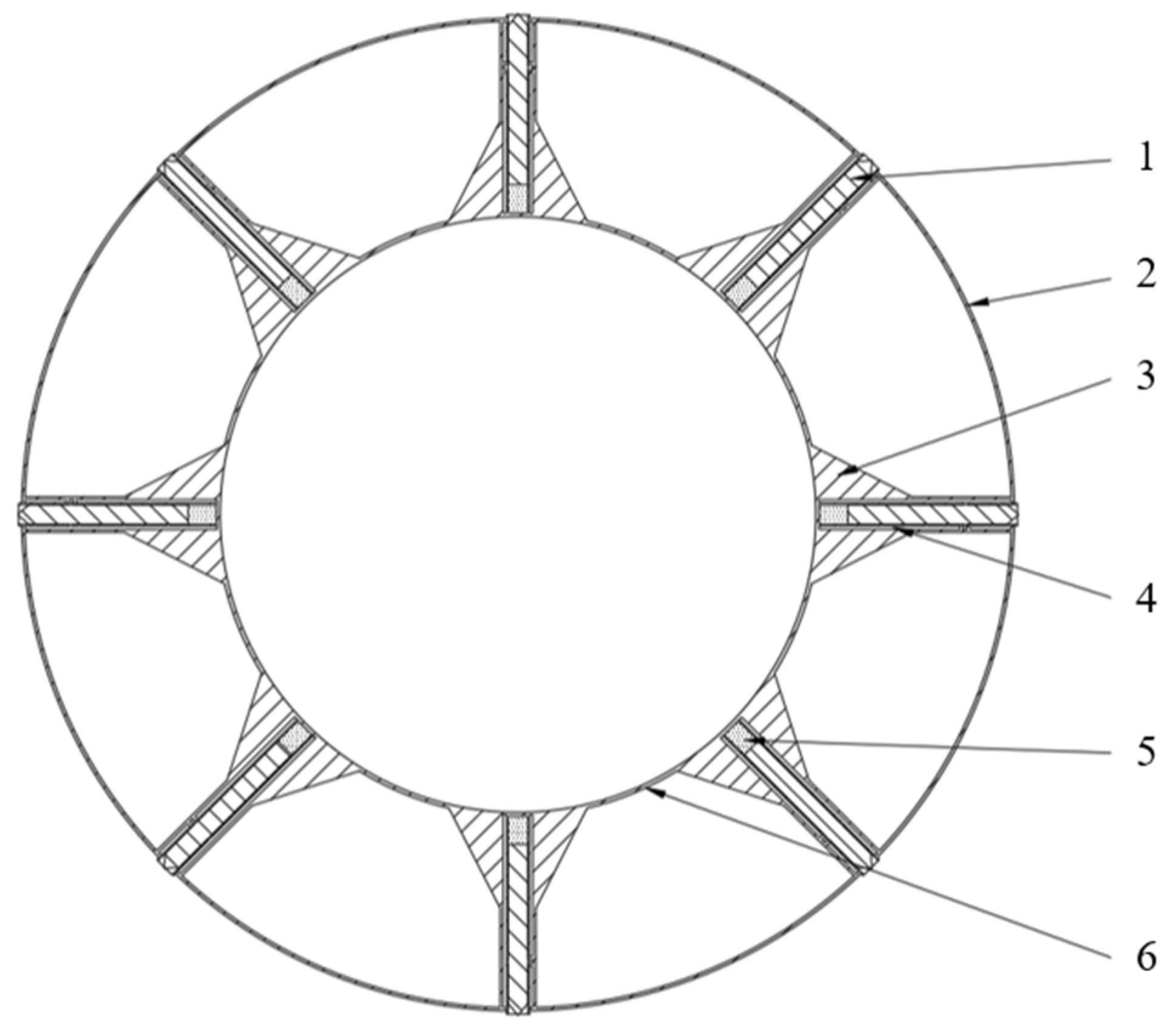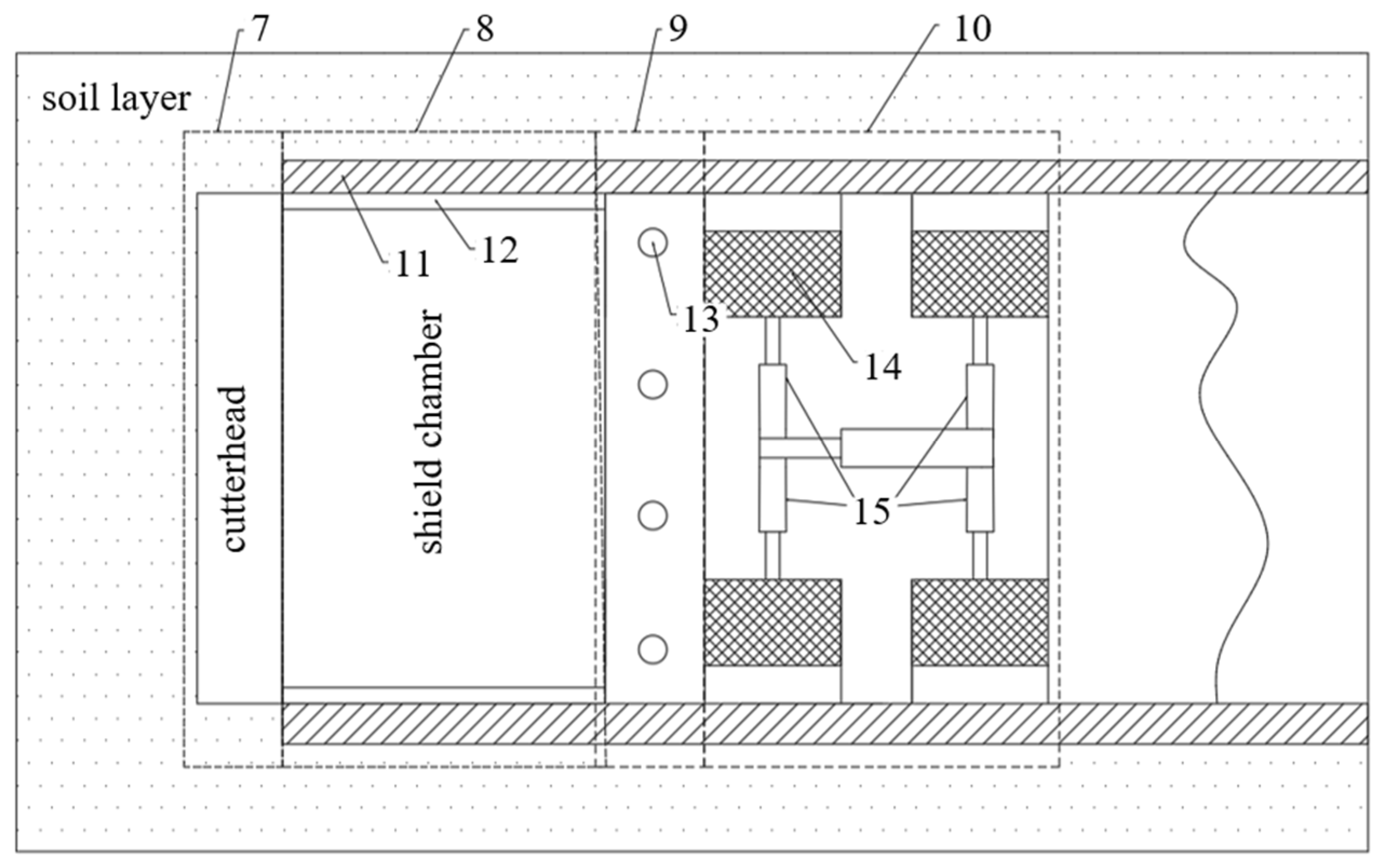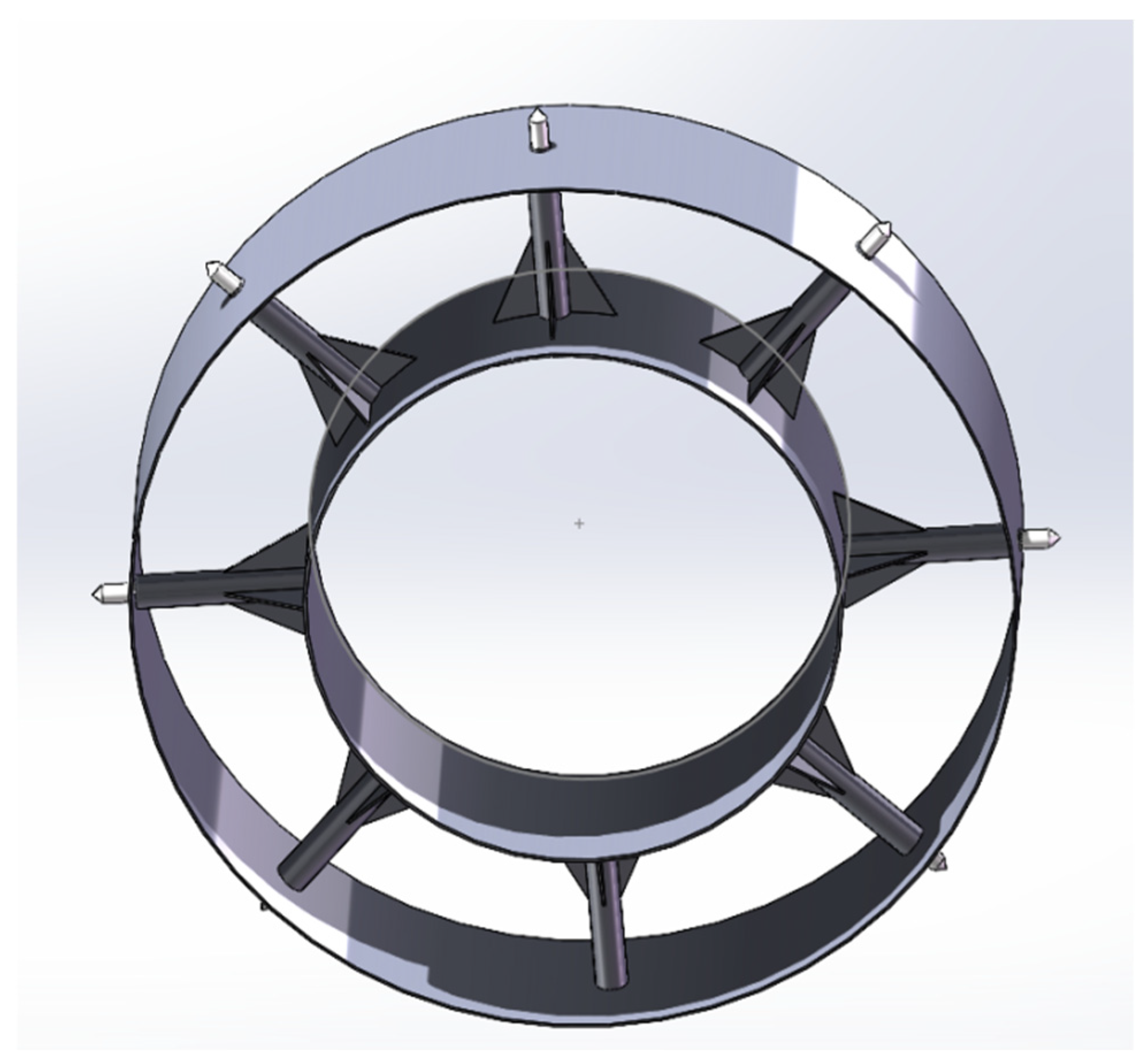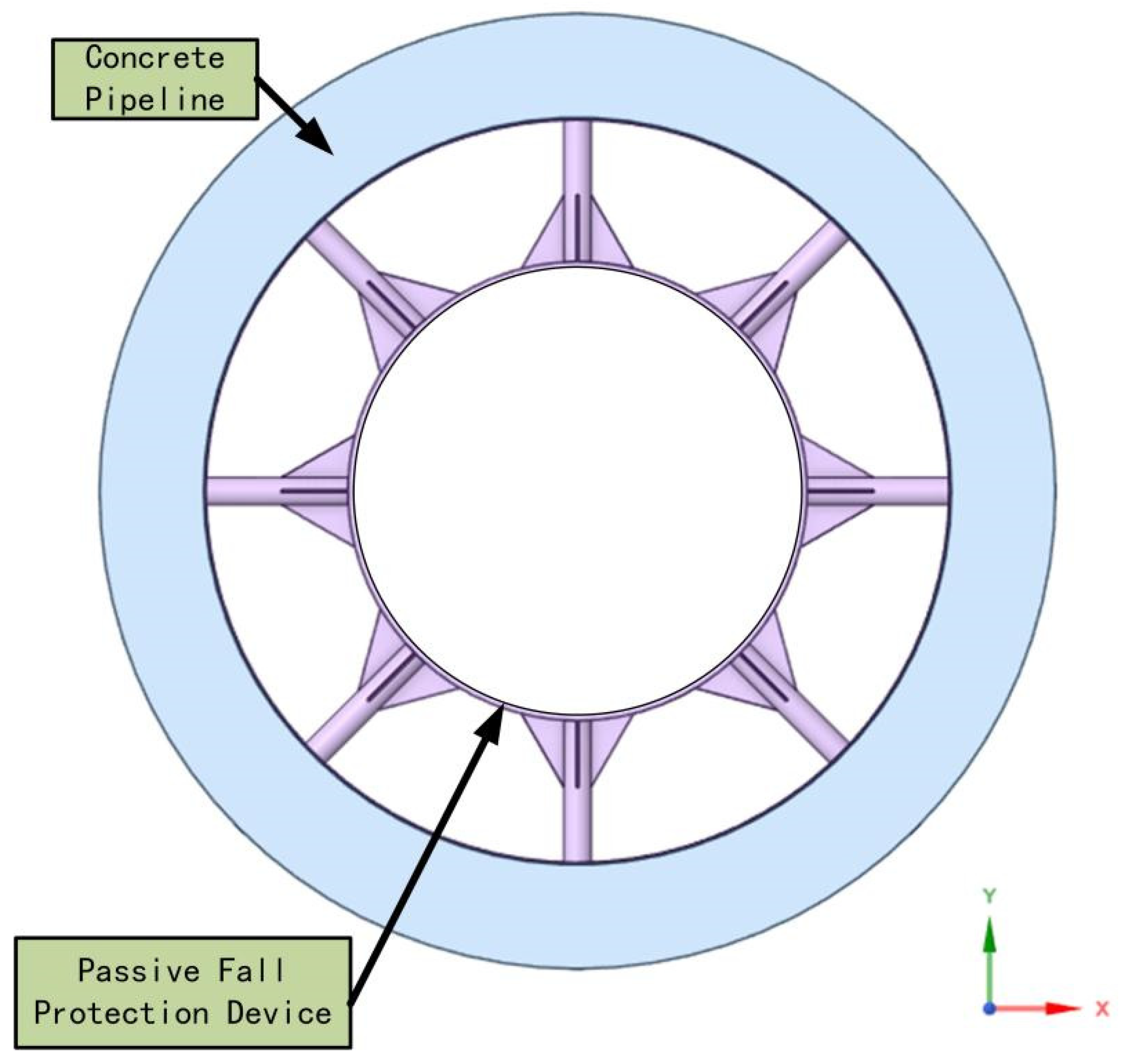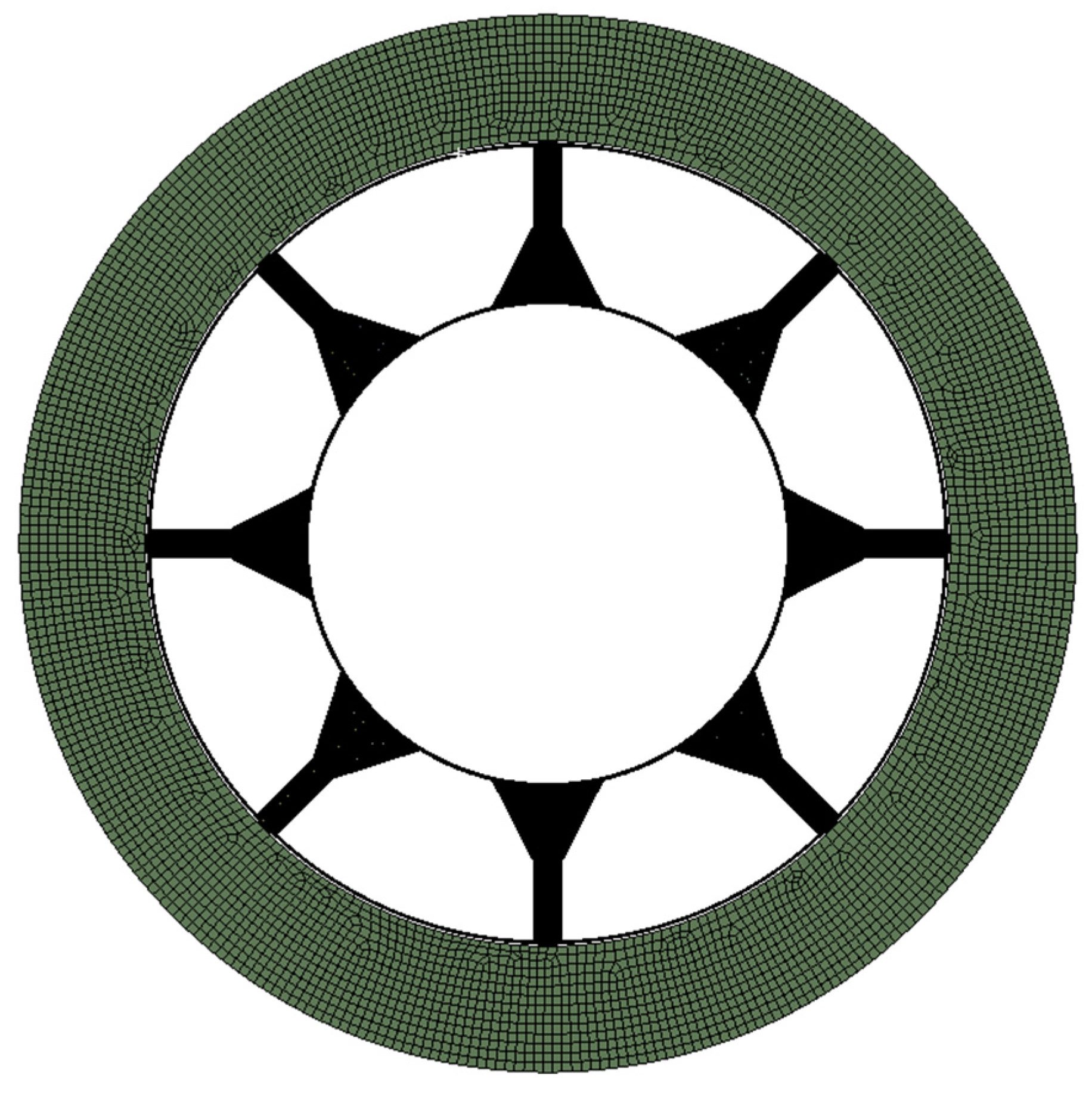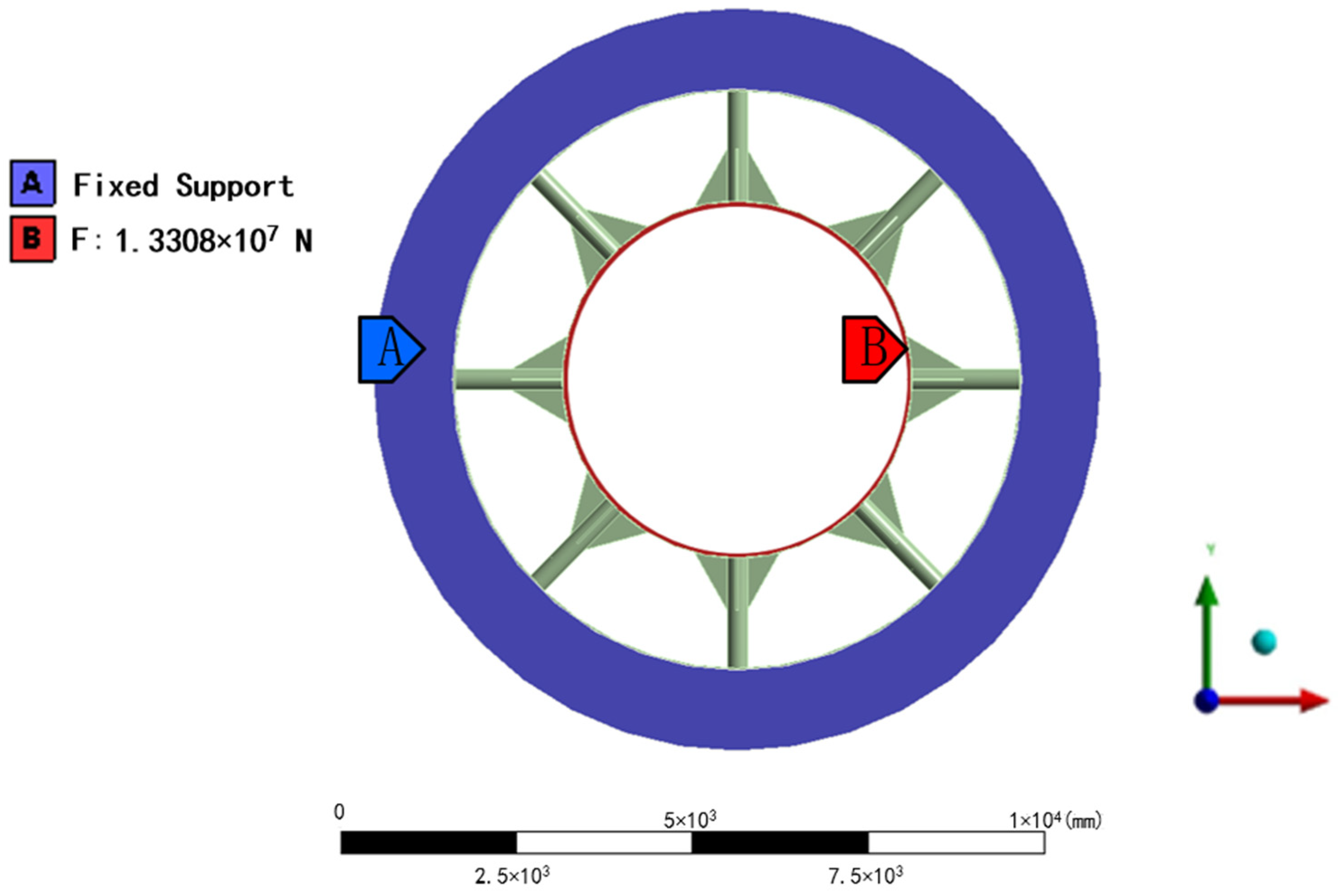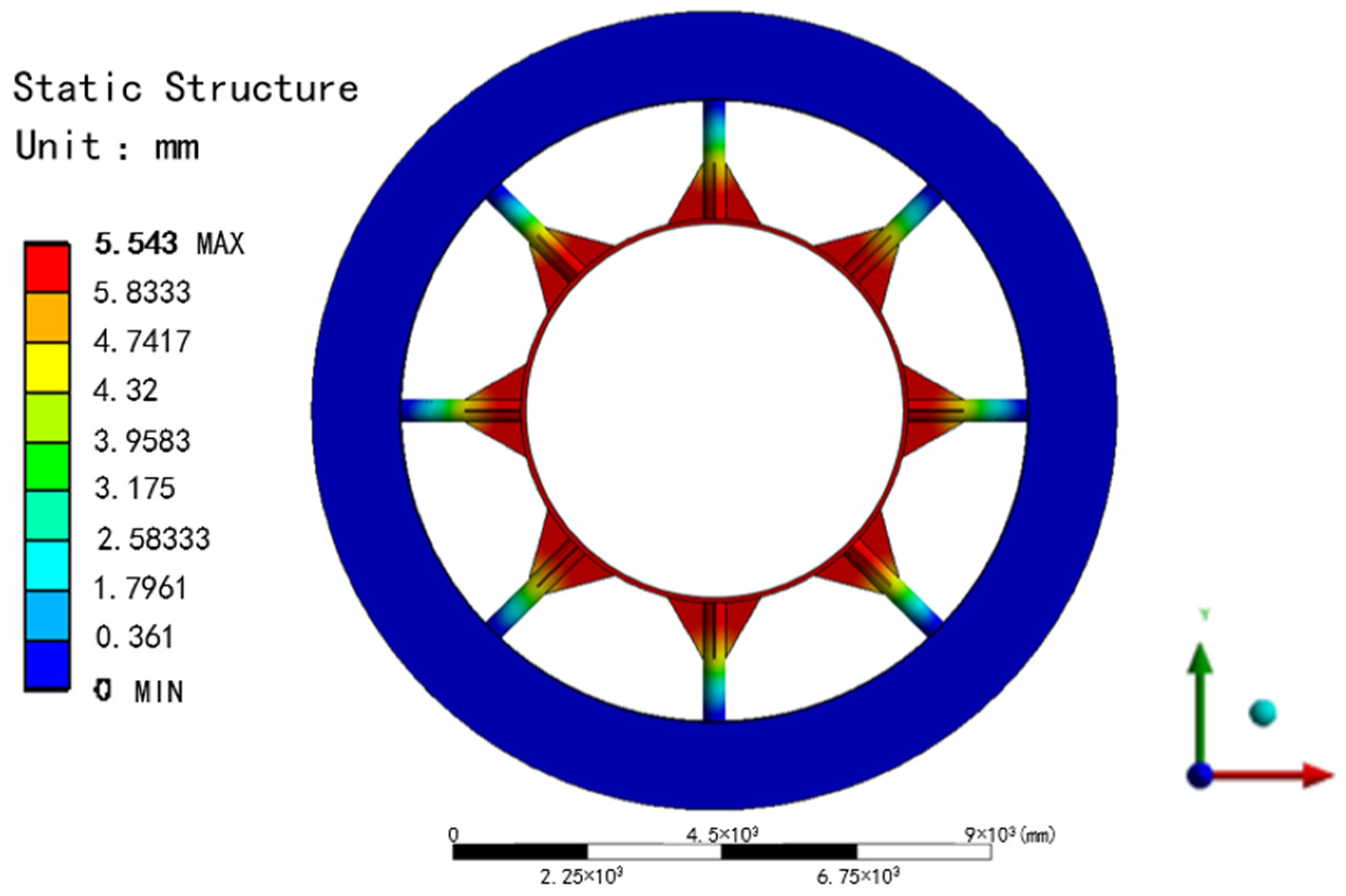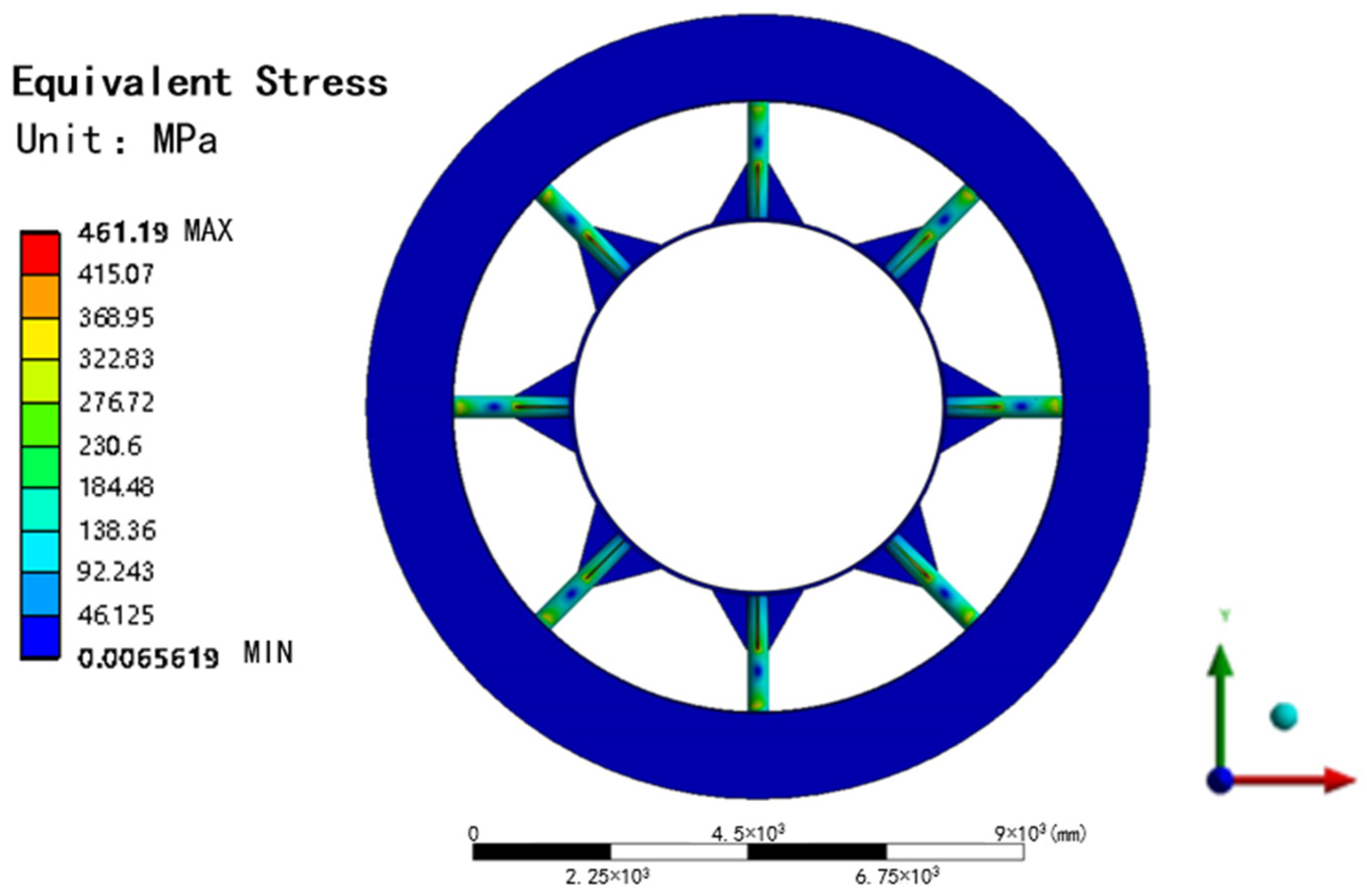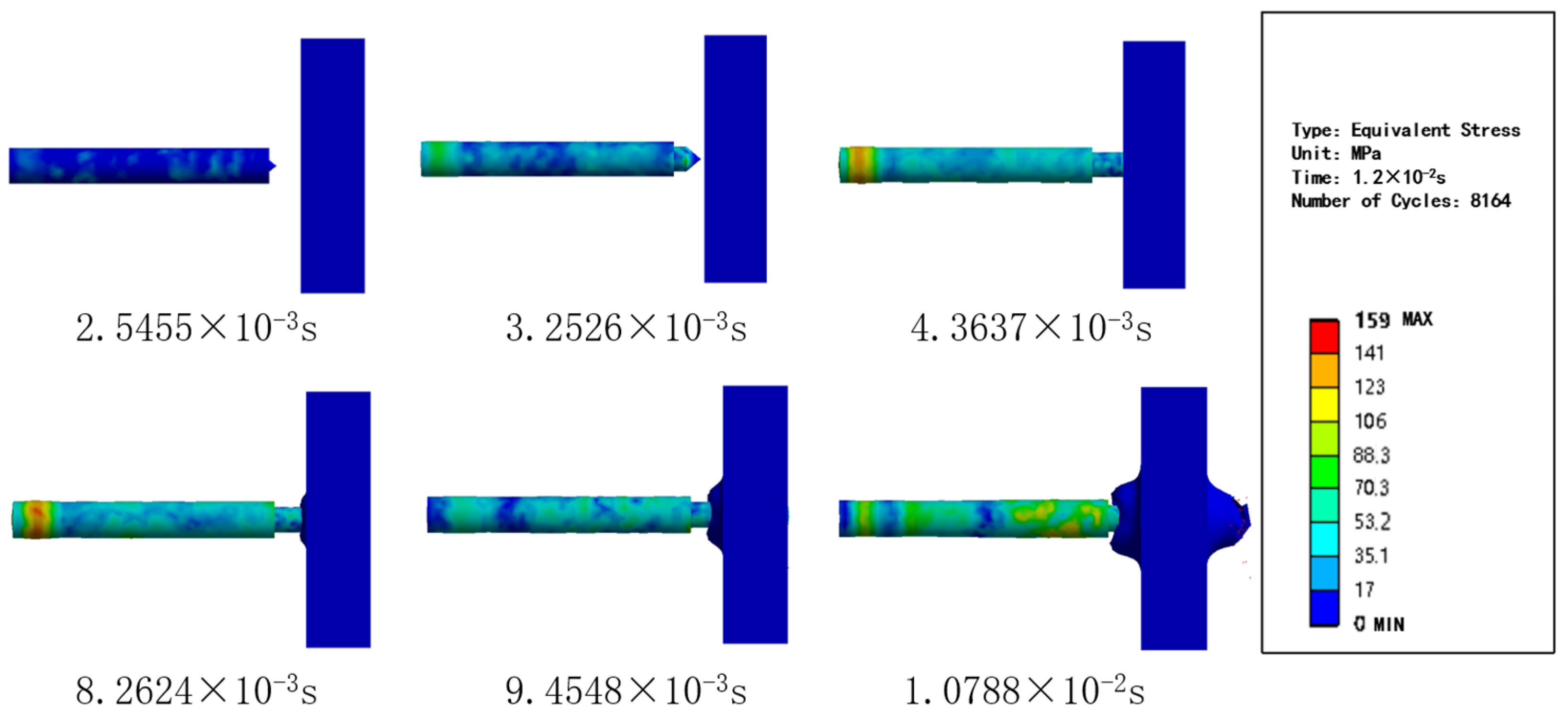2.2. Self-Responsive Operational Logic Design
The design of anti-falling systems for tunnel boring machines (TBMs) operating in complex dynamic environments necessitates robust theoretical foundations to address challenges such as real-time signal processing, noise suppression, and multimodal feature fusion. This section establishes the core signal processing framework underpinning the proposed self-responsive anti-falling device, integrating noise-resistant filtering algorithms and decision logic validated through empirical studies. Key components include:
2.2.1. Signal Processing Models
A sliding-window weighted average algorithm is employed to suppress high-frequency noise:
Window width: N = 50. Weight coefficients w[k] use an Hamming window (sidelobe attenuation: −53 dB), effectively suppressing noise components > 200 Hz.
- 2.
Butterworth Low-Pass Filter
A fourth-order Butterworth filter is designed with the transfer function:
Cutoff frequency = 100 Hz (corresponding to the −3 dB attenuation point). Group delay compensation achieves zero-phase distortion via forward-backward filtering.
2.2.2. Multimodal Fusion Decision-Making
Acceleration energy features are calculated within a sliding window (
N = 100):
Primary warning triggered when RMS > 5 g, corresponding to the energy accumulation phase during initial falling.
- 2.
Short-Term Energy (STE)
Signal envelopes are extracted using the Hilbert transform:
Threshold set to 120 g2·ms, ensuring a false alarm rate < 0.3% at 0.5σ noise levels.
- 3.
Zero-Crossing Rate (ZCR)
Quantifies signal frequency-domain characteristics:
Normal vibration: ZCR > 25 crossings/ms. Falling events: ZCR < 8 crossings/100 ms, enabling frequency-domain discrimination.
The self-responsive anti-falling system achieves millisecond-level response during initial falling stages through multimodal data fusion and rapid decision-making mechanisms, as shown in
Figure 2.
During system initialization, parameters are configured as follows:
Sampling frequency: 2000 Hz
Butterworth low-pass filter (cutoff frequency: 100 Hz)
Dynamic acceleration threshold: 5 g.
Three redundant MEMS accelerometers (range: ±50 g, bandwidth: 1 kHz) continuously acquire triaxial acceleration data. Signal processing involves:
Moving average filtering (window width: 50 points)
Low-pass filtering for high-frequency noise suppression
Multicriteria fusion algorithm integrating:
- •
Root mean square (RMS) acceleration over 50-ms windows
- •
Short-term energy (STE) threshold: >120 g2·ms
- •
Zero-crossing rate (ZCR) analysis.
A falling event is confirmed when both conditions are present:
Upon detection, the capacitive energy storage module ignites TNT propellant within 0.05 ms, driving Q690D low-alloy steel (yield strength 791 MPa, ultimate tensile strength 863 MPa) telescopic columns to penetrate C40 concrete linings (compressive strength 40 MPa). Real-time displacement monitoring via Hall sensors ensures:
All operational data (acceleration profiles, trigger states, actuator feedback) are recorded in a crash-resistant black box (sampling rate: 10 kHz); this higher sampling rate ensures precise reconstruction of transient events during post-incident analysis, while the primary signal processing chain operates at 2000 Hz for real-time detection efficiency.
To validate the robustness of the signal processing framework under real-world noise conditions, Monte Carlo simulations were conducted with 10
5 sets of noise-contaminated acceleration signals, signal-to-noise ratio (SNR) = 5–30 dB. This stochastic approach rigorously evaluates the algorithm’s tolerance to signal variability and environmental uncertainties, ensuring reliable performance across diverse operational scenarios. Key metrics include detection rate and false alarm probability, benchmarked against standalone feature thresholds and the proposed fusion strategy, which are analyzed in
Table 2:
The Monte Carlo results demonstrate that the multimodal fusion algorithm achieves near-perfect detection rates (99.8%) and ultra-low false alarms (0.3%), outperforming individual feature-based methods by 8.1–17.5% in detection accuracy and reducing false alarms by 98.4–99.2%. This validates the framework’s robustness against noise and its capability to meet stringent safety requirements for TBM fall prevention. The fusion strategy effectively mitigates the limitations of single-feature decision-making, offering a statistically grounded solution for real-time hazard identification in high-risk tunneling environments.
2.3. Optimized Design of Self-Responsive Anti-Fall Device
In TBM tunneling operations, hydraulic support systems serve as critical stabilization subsystems, ensuring safety through coordinated actions of front shield grippers, stabilizers, thrust shield grippers, and rear support grippers [
22,
23]. These systems maintain equipment stability through three principal technical features:
Annular Hydraulic Layout (
Figure 3a): The front shield grippers and stabilizers employ a circumferential hydraulic cylinder configuration, providing multi-point contact support around the shield structure. Field measurements demonstrate 58–72% reduction in cutterhead oscillation amplitude during steep-inclination tunneling [
24,
25,
26].
Composite Load-Bearing Structure: The thrust shield integrates bilateral locking mechanisms and top auxiliary supports, delivering equivalent support strength of 14.3–18.6 MN/m
2 in sandstone strata [
27].
Adaptive Rear Support (
Figure 3c): The trailing gear features dynamically adjustable grippers with pressure feedback control, reducing cumulative displacement errors during stepping cycles by 41% [
20].
Despite advantages including high stiffness (>6.8 MN/m
2) [
28], hydraulic systems exhibit the following critical limitations:
Slow response time (150 ms)
High failure rate (mean time between failures [MTBF] = 1250 h)
Excessive energy consumption (>17 kW·h/m)
37% of secondary downtime caused by valve blockages from oil contamination.
TBMs, known for their extreme operational demands and high-performance requirements in hard rock tunneling, often face complex and adverse geological conditions during construction. Existing TBM systems suffer from poor coordination between support loads and propulsion loads, leading to inadequate adaptability to heterogeneous rock formations and a high risk of engineering accidents. Improper design of the support-thrust system can cause uneven contact between gripper shoes and the surrounding rock, resulting in critical failures such as insufficient lateral wall support, severe machine vibrations, unstable gripping, and tunnel wall collapses [
29], as shown in
Figure 4. Specific technical challenges include tunnel collapses in fractured rock, unstable gripper shoe contact, cutterhead subsidence or jamming, loss of directional control [
30], stress concentration-induced rock failure in soft formations, and gripper slippage due to insufficient ground contact pressure in hard rock formations [
31,
32]. These issues primarily stem from non-uniform gripper–rock contact and gripper instability, highlighting the critical importance of uniform contact performance between gripper shoes and the surrounding rock. Consequently, TBM operation heavily depends on the support mechanism, where the rationality of gripper design and contact quality directly determines tunneling efficiency and safety. However, even with optimized gripper contact performance, sudden falling risks persist. Furthermore, hydraulic gripper systems exhibit significant drawbacks, including high hydraulic pipeline failure rates (MTBF = 1250 h), excessive energy consumption (>17 kW·h/m), and slow response times (150 ms per actuation), all of which severely undermine long-term operational reliability. Engineering practices indicate that approximately 37% of minor downtime incidents are caused by hydraulic valve blockages due to oil contamination, further underscoring the necessity of passive anti-falling systems.
As supplementary protection, the conventional anchoring system (
Figure 3b) deploys pre-stressed rock bolts (spacing: 1.2 m, pullout resistance ≥ 180 kN/bolt) behind the thrust shield, limiting equipment slippage to <2.1 mm within 72 h [
33]. However, this method shows 22.4% failure probability in fractured rock masses due to poor geological adaptability and prolonged installation cycles [
34,
35].
Table 3 shows the comparative analysis of different anti-falling systems:
The self-responsive anti-falling device mainly consists of (1) telescopic columns, (2) outer ring casing, (3) reinforcing ribs, (4) telescopic column tubes, (5) propellant, and (6) inner ring casing. When the TBM falls, the telescopic columns will rapidly extend and penetrate into the concrete tunnel, securing the TBM in the inclined shaft, as shown in
Figure 5. The components in this figure function as listed below.
Telescopic column: Used to rapidly deploy during TBM falling incidents, penetrating the concrete tunnel walls of inclined shafts to secure the TBM.
Outer casing: The external structure of the device, designed to fix the telescopic columns and other internal components.
Reinforcement ribs: Enhance the structural strength of the outer casing to prevent deformation under high stress.
Telescopic column tube: Accommodates and guides the deployment process of the telescopic columns, ensuring smooth extension under propellant activation.
Propellant: Provides the driving force for telescopic column deployment.
Inner casing: The internal annular structure responsible for connecting and securing internal components.
The self-responsive anti-falling device installation configuration is as follows:
The self-responsive anti-falling device is strategically positioned at the mid-section of inclined shaft TBMs, specifically between the shield chamber and dual X-type anti-falling mechanisms (
Figure 6). This optimized placement ensures structural integrity preservation, while enabling rapid penetration of telescopic columns into concrete lining walls during fall events.
As illustrated in
Figure 6, the key components are arranged as follows:
Cutter Head (7): The front cutting component of the TBM, designed to excavate and fragment soil or rock during tunneling operations.
Shield Chamber (8): The main body of the TBM housing mechanical systems and control units, responsible for excavation, ground support, and propulsion.
Self-responsive Anti-Falling Device (9): A ring-shaped system installed at the rear of the shield chamber. It detects abnormal acceleration and activates fall-prevention mechanisms to arrest TBM slippage.
Dual X-Type Anti-Falling Device (10): Primary fall-prevention system within the shield chamber, featuring a dual X-shaped configuration. Equipped with multiple gripper shoes and hydraulic jacks, it stabilizes the TBM during routine excavation to prevent slippage.
Segments (11): Precast concrete blocks assembled to form tunnel linings, ensuring structural stability through circumferential support.
Shield Shell (12): The external protective casing of the TBM, engineered to withstand ground pressures while safeguarding internal components during excavation.
Telescopic Column (13): A critical component of Device 9 (Self-responsive Anti-Falling Device). Upon detecting anomalies, it deploys via a propulsion system to embed into surrounding concrete walls, arresting TBM movement.
Gripper Shoes (14): Integral to Device 10 (Dual X-Type System). During normal operation, these hydraulically-actuated elements extend to frictionally engage tunnel walls, preventing inclined tunnel slippage.
Hydraulic Jacks (15): The power units of Device 10, enabling both anti-falling functions and TBM advancement through controlled extension/retraction of gripper shoes.
The installation topology achieves three critical objectives:
Force Transmission Optimization: Positions the device within the maximum bending moment region (calculated at 1.3% of TBM length from cutterhead)
Redundancy Enhancement: Forms cascaded protection with dual X-type mechanisms
Space Efficiency: Requires only 1.2 m axial installation space.
Comparative analysis of fall protection system optimization is shown in
Table 4:
Through systematic optimization of inclined shaft TBM anti-falling systems, the conventional hydraulic support with rock bolt reinforcement has been upgraded to an integrated hydraulic-mechanical hybrid configuration. Key improvements include:
Response Acceleration: 12.5 × faster emergency triggering (12 ms vs. 150 ms)
Energy Efficiency: Energy consumption per activation equals 0.7 min of hydraulic system operation
Adaptability Enhancement: Operational capability extended to RQD 20% fractured zones
Cost Effectiveness: 41% total cost reduction achieved through decreased labor requirements and bolt consumption savings.
The optimized system demonstrates superior performance in extreme conditions (slopes ≤ 49°, humidity ≤ 95%, vibration ≤ 8 Grms), with field tests confirming 135 mm maximum arrest displacement versus 520 mm in legacy systems. This innovation significantly enhances construction safety while reducing environmental impact through material consumption minimization.
